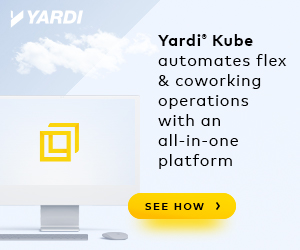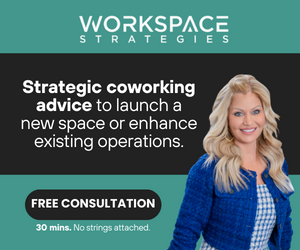- Several reports have indicated that working from home can be detrimental to remote workers’ overall wellbeing. Alternative workspaces are now being sought by those who no longer benefit from this work model.
- With more workers prioritizing all aspects of their wellbeing, will this boost the number of people seeking to work near home (in coworking spaces, for instance)?
- A home-away-from-home approach to office design could encourage workers to leave their home workstations and move into hybrid working or coworking locations.
As the potential health risks of working from home become more apparent, working near home is emerging as a more attractive work model. Working near home means being situated in one of two core work environments — spaces typically in the hospitality and leisure sector (cafés/coffee shops/hotel lounges) and coworking spaces.
Each environment offers an alternative to working from home, and both provide similar advantages (assuming they are locally situated). Companies that offer shared work spaces are currently upping their game to attract new customers who no longer want to work from home full-time.
New thinking about our relationship with work
The future of work depends on reimagining the concept of the office. According to Mark Dixon, Chief Executive of IWG, an office no longer needs to be seen as one physical location. Offices can be digital spaces, but they can also be anywhere that enables workers to be their most productive (at that time).
The most flexible workplace is, therefore, an “anywhere office.” When employees need to operate in a particular building, the best option is a workspace design based on a combination of the latest technology and wellness features.
Increasingly, employees who have chosen to work in an office base that decision on how well the design of the office supports their overall wellbeing. Today’s offices are built for flexibility and are often designed in line with the behavior and habits of the workforce they serve.
Offices need to reflect the change in how people perform their roles and the value they assign to their work. Employees now want their offices to contain more wellness elements such as biophilic design, ergonomic furniture, ethically-sourced equipment, and air quality monitoring systems.
Working from home is still coveted by many employees, but research has revealed generational differences in how employees have adapted to this model. 81% of workers under thirty-five cite loneliness as an issue when working from home.
It appears that Generation Z and Millennials are more prone to isolation because they have had less time to develop social relationships with colleagues. The social element of work is a key driver behind increased productivity for younger generations of workers.
Employers who offer the work-from-home option should therefore ensure that they have programs in place to provide opportunities for social interaction between employees at all levels.
The need for more personalized workspaces
For many, the hybrid model will offer all the benefits of working from home and the office without many of the pitfalls of being based permanently in one space.
The provision of more personalized work experiences could encourage employees to spend time in the office. Personalization means having a sense of attachment to a space.
Personalized spaces range from places to display personal items, such as photos of loved ones or a favorite mug, to employee involvement in office design. Research has shown that increased personalization offers employees a greater sense of belonging (to a company) and can lead to increased job satisfaction and productivity.
Employees need to perceive an entire office or floor space as “belonging” to them, not just a desk space of X meters squared. Even within shared workspaces, there are opportunities for employers to ‘make the workspace feel more like home’ rather than impersonal and (worse) sterile.
There is a need to rethink personalization, whether working near home (at a local coworking space) or engaging in hybrid work practices. Certain architectural features — such as open staircases and storage spaces for personal items — should be built into coworking spaces or offices where hybrid working is the norm.
The inclusion of elements such as water refill points, chillout rooms, and lunch spaces will also foster a sense of social belonging, as employees (in an office) or members of a coworking space are encouraged to interact and collaborate.
Some companies even consult workers on what features they would like to see included in a coworking space or shared office. This “democratization” of the design process provides a more inclusive and personalized work experience.
Coworking spaces may not be able to offer widespread democratization of the design process, but there are certain features that they can provide to personalize the experience of coworking members. These offers include:
- Customized IT support
- Hosting dedicated company servers
- Private or semi-private bays
- Flexible packages (with passes to various local clubs and events)
- Bike sheds and storage space
- Options to share space with a work partner
- Business support clubs for networking
Providing the infrastructure to encourage working near home
Increasingly, employers are adopting a new(ish) trend known as the hub-and-spoke office model. This model is based on one centrally-based office (the hub) with several locally-based satellite offices (the spokes).
In companies without ‘spokes,’ employers should consider offering incentives such as subsidized coworking space membership as this model works well for employees who want to work closer to home.
Could the ‘work near home’ model become a viable middle ground between working full-time from home and working five days a week in the office? The uptake of this option could certainly be boosted through joined-up thinking and collaboration between local authorities, businesses, and private investors.
Government agencies could also support this process through policies that encourage this work model — for instance, zoning regulations, tax incentives and grants for coworking spaces. The development and implementation of these strategies could create ecosystems that render working near home an attractive and viable option for remote workers.
With so many different approaches and increased personalization of work, it would appear that the future of work is one in which employee choice and autonomy take center stage.

 Dr. Gleb Tsipursky – The Office Whisperer
Dr. Gleb Tsipursky – The Office Whisperer Cat Johnson – Coworking Marketing Maven
Cat Johnson – Coworking Marketing Maven Angela Howard – Culture Expert
Angela Howard – Culture Expert Drew Jones – Design & Innovation
Drew Jones – Design & Innovation Andrea Pirrotti-Dranchak – Competitive Advantage
Andrea Pirrotti-Dranchak – Competitive Advantage Jonathan Price – CRE & Flex Expert
Jonathan Price – CRE & Flex Expert Jeremy Fennema – Tech Innovation Alchemist
Jeremy Fennema – Tech Innovation Alchemist







